Mackay women knit socks for men in World War I trenches
While beloved sons fought on foreign soil and in trench warfare, groups of women answered the urgent call to help their men one ball of wool at a time. SPECIAL FEATURE
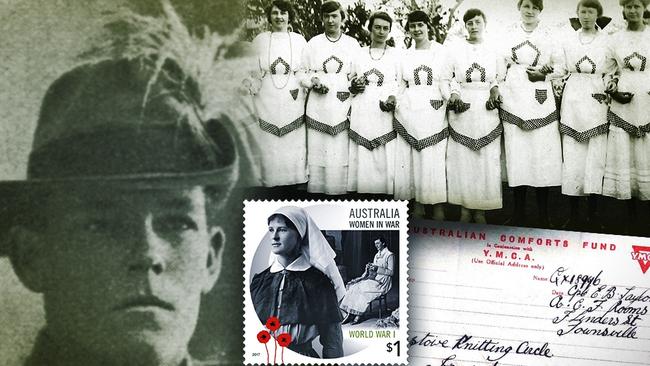
Mackay
Don't miss out on the headlines from Mackay. Followed categories will be added to My News.
As Mackay’s sons fought on foreign soil in World War I groups of women at home began knitting their way to offer support one ball of wool at a time.
Not only did the click of their needles provide much needed socks to men on the frontline, but their fundraising efforts would also ensure a lasting tribute to their service.
With conditions on the Western Front constantly wet and cold, soldiers wore two pairs of socks amid the fear of contracting trench foot.
Poorly insulated boots meant socks sometimes only lasted a day or at best few weeks, creating a constant shortage of socks.
Without dry feet, the Allied forces could not survive the rigours of war and maintain a strong defence.
With the outbreak of war, the Red Cross mobilised to create the Australian Comforts Fund in August 1916 and rallied women to knit a million pairs of socks.
The Red Cross Society Mackay branch president Mrs J Michelmore put out the call for locals to contribute to the national appeal.
She urged all people who could knit to do so, with wool supplied free and lessons available at the Red Cross rooms on Tuesday and Friday afternoons.
She outlined the specific requirements to have a perfect fit; socks should be as plain as possible, no fancy stitches and no back seam and especially no knots.
“When casting on allow as loose as possible. Remember that men on active service have every muscle developed and calf measurement is considerably greater after being in training for some months,” Mrs Michelmore said.
Smaller knitting circles started in communities such as Farleigh to send socks directly to local men at war.
For those at home, life in Mackay was tough for a community still relatively isolated in terms of rail and road connections.
Knitting circles became places for women to share their fears and grief, and to ease their loneliness in the bleak years, knowing they were at least doing something to help.
Our women soon learned how much their work was appreciated.

In October 1917 a report from the Daily Mercury’s Farleigh correspondent noted a wave of enthusiasm prevailed among members of the Soldiers’ Socks and Comforts Fund Committee following receipt of many letters from the lads at the front, gratefully acknowledging the parcels.
“It is questionable whether the arrival of the parcels in France or the arrival of their acknowledgment in Australia caused the more excitement.”
It’s not known how many pairs of socks came out of Mackay, however a September 1918 letter from the Soldiers’ Sock Fund joint home secretary Nell Ahern thanked the Mackay and district for their consignment of 307 pairs.
“Your knitters are splendid workers without doubt and the socks a credit to them,” she wrote.
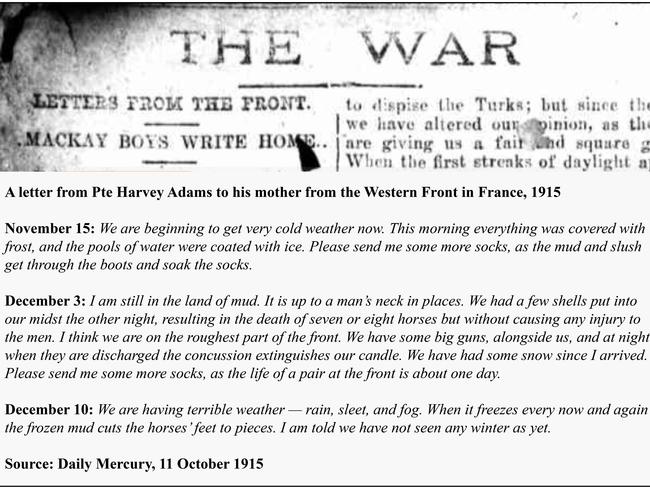
Their efforts were warmly appreciated with returned serviceman sharing their thanks at a welcome home social for eight returned servicemen in Farleigh.
In November 1918 the Daily Mercury Driver reported Driver Private George Furlong from the 2nd Light Horse Regiment (C Squadron) / 28th Company, Australian Army Service Corps, thanked the “Farleighites” for a warm reception, saying they owed a deep debt of gratitude for the many parcels of comforts received while on the battlefield which helped to ameliorate their war-worn condition.
“He was glad to be able to assure them that each parcel was received with the deepest gratitude towards their warm-hearted friends at home,” the article said.
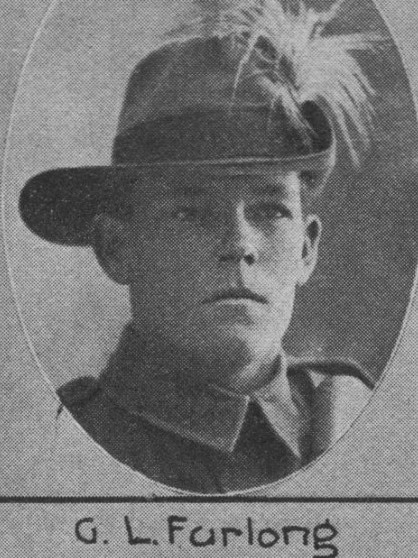
Women again picked up their needles in World War II.
At the Eungella Chalet balls of wool, needles and patterns rested on a table with any visiting woman invited to knit a row or two while enjoying the spectacular view and mountain air.
In 1940 the Daily Mercury reported ladies from Eungella visited the Netherdale Comforts Fund and enjoyed afternoon tea and an evening of entertainment.
“The visitors inspected the large parcels of knitted goods, cases of tinned food, parcels of flannels, etc., that were packed ready to be sent away, and one visitor passed the remark that the Netherdale committee was certainly doing its bit to help our young Diggers have some comfort while ‘scrapping’ for us overseas.”
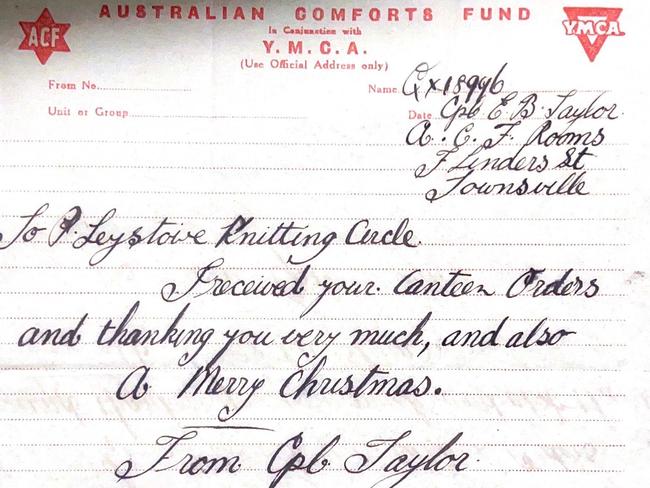
With the outbreak of WWII the Pleystowe Knitting Circle was active by 1941, holding social afternoons in the School of Arts where the honour board would later be installed.
Others opened their homes for functions.
“A delightful out-of-doors afternoon was held at the home of Mr. and Mrs. J. C. Collier, Pleystowe, on Wednesday, the proceeds being in aid of the Pleystowe Knitting Circle.
“The spacious lawns, shade trees, and flowering annuals, made a delightful setting. Numerous games and competitions kept the afternoon full. Mrs. J. Evetts won a treasure hunt. Bridge and euchre were enjoyed.”
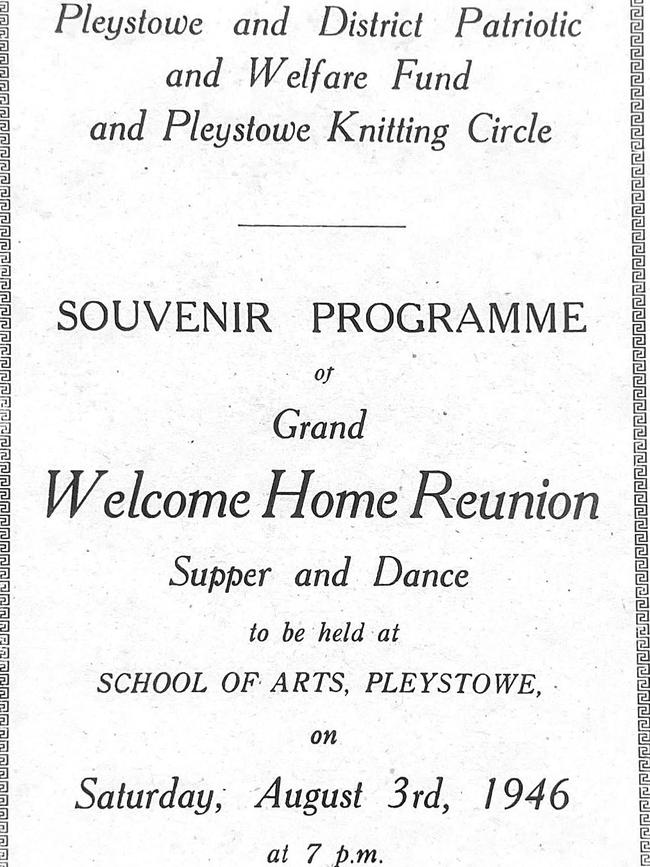
The Pleystowe Knitting Circle through the Pleystowe Patriotic Fund erected an honour roll to commemorate those who served in WWII.
It lists the names of 80 men, including nine who were killed in action.
In April 1948 a dedication ceremony was held for the honour board and nine trees were planted in the Pleystowe Memorial Ave to honour the memory of the men who had died as a result of war service
The silky oak timber honour board was originally located in the Pleystowe School of Arts Hall in the grounds of Pleystowe Sugar Mill.
After the School of Arts hall was demolished in 2001, the honour board was restored in 2005. It is now displayed with pride in the offices of Mackay Sugar at the Pleystowe Mill site.
At Farleigh Mill, a copper embossed honour board was erected by the Socks and Comforts Committee in 1918 and was unveiled by Mrs Augustus Furlong who had several sons serve in the war, and by Miss Annie Duncan, whose brother Charlie was the only Farleigh native to pay the extreme penalty.
Lest We Forget.




